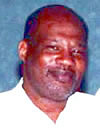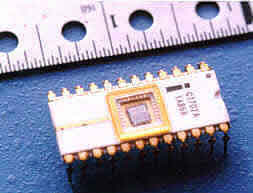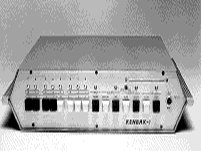click on the home button to go to the home page
|
The Industrial Era 1970 - 1971 This is a year that spawns more than one controversy: who invented the microprocessor first and what was the first microcomputer. The first controversy even has been fought out in court! The first computers fully based on IC technology come on the market. The programming language "C" is invented The first Micro Processor is marketed |
pre history | antiquity |
pre industrial era | industrial
era
1947 - 1950 - 1952
- 1955 - 1958 - 1961
- 1963 - 1965 - 1969
- 1970 - 1972
- 1974 - 1976 - 1978
- 1980 - 1981 - 1982
- 1984 - 1986 -
1989 - 1991 - 1993 - 1994
- 1996 - 2000 - 2002
| Related Articles |
| Related Resources |
|
|
![]() It is Gilbert
Hyatt who takes the IC technology a step further and files for a patent
for the Micro Processor. But the paperwork took a long time to get through the
"windings" of the patent bureau. Three engineers from Intel Corporation
were faster and they created the first commercially viable microprocessor. That
is why those three are accredited to have invented the microprocessor, however
Hyatt will be awarded the patent in 1990 after all. A similar case to that of
Atanasov with his first electronic computer.
It is Gilbert
Hyatt who takes the IC technology a step further and files for a patent
for the Micro Processor. But the paperwork took a long time to get through the
"windings" of the patent bureau. Three engineers from Intel Corporation
were faster and they created the first commercially viable microprocessor. That
is why those three are accredited to have invented the microprocessor, however
Hyatt will be awarded the patent in 1990 after all. A similar case to that of
Atanasov with his first electronic computer.
![]() Ray Holt,
working with his brother - Bill holt - on an engineering team, designs the onboard
main flight computer for the U.S. Navy's F-14A "Tomcat" fighter jet.
It is a computer on a chip and this processor is more powerful than the 4004
designed by Intel. The project started in 1968.
Ray Holt,
working with his brother - Bill holt - on an engineering team, designs the onboard
main flight computer for the U.S. Navy's F-14A "Tomcat" fighter jet.
It is a computer on a chip and this processor is more powerful than the 4004
designed by Intel. The project started in 1968.
Ray Holt is getting his chance to claim to be the father of the microprocessor not before 1999.
It will take Holt 30 years to have the Navy declassify the project and be able to make his invention known to the public.
Interviews with Holt's co-workers and his own documents confirm that their work preceded the 1969-1971 efforts of Santa Clara-based Intel Corp. that turned the microprocessor into a business empire. "It was very frustrating," says Holt, about keeping silent for so long. "I almost had to forget about it." (1)
![]() Ken
Thompson develops the programming
language 'B' of which stems the language 'C'. It is said that the name like
that is chosen because there already was a prototype of this or another language
called "A".
Ken
Thompson develops the programming
language 'B' of which stems the language 'C'. It is said that the name like
that is chosen because there already was a prototype of this or another language
called "A".
![]() The theory
of Relational Database is introduced by Ted
Codd at IBM. However algebraic laws for query optimization were not formulated
here.(3) With this model though it became possible to work
with data represented as a form to fill out without having to tell the computer
how to store and were to find it back.
The theory
of Relational Database is introduced by Ted
Codd at IBM. However algebraic laws for query optimization were not formulated
here.(3) With this model though it became possible to work
with data represented as a form to fill out without having to tell the computer
how to store and were to find it back.
![]() The eight inch
(15) floppy disk
is developed by OPIUM and IBM. The first floppy disk measures 8 inch in diameter
(1 inch = 25,4 mm). The first type is of a read only format. Officially the
floppy wil lbe announce one year later and used for the IBM mainframe's data
storage cabinet IBM 3330
The eight inch
(15) floppy disk
is developed by OPIUM and IBM. The first floppy disk measures 8 inch in diameter
(1 inch = 25,4 mm). The first type is of a read only format. Officially the
floppy wil lbe announce one year later and used for the IBM mainframe's data
storage cabinet IBM 3330
This disk is built from an 8" plastic disk on which a thin magnetic layer is applied on a single side. The storage capacity is 100-130 Kbytes, about 60 pages A4. The first versions were used without any external protection, soon dust forms a problem and the floppy is put into an square envelop lined with some protective material inside. A hole in the middle is for the driving spindle that turns the disk around and the slot to provide access to the floppy's data for the read and write head(16) of the disk drive. The drives and floppies are extremely expensive and only large companies can afford to buy them. This new medium will also not be received favorably at first because it is mainly used in a mainframe environment. In later develpments so called hard disks and so called storage packs, also called Winchester disks, and tapes that can contain many mega bytes will dwarf this floppy disk, to render the floppy almost useless for large mainframes.
Alan Shugart at IBM invents the first regular use of an 8 inch "floppy" (magnetic storage) or diskette: for DisplayWrite an IBM word processor.(19) (see also the official release date in 1971)
![]() Pascal-a
is developed by Niclaus Wirth (Swiss). Pascal
supports development of software because it allowed the programmer to divide
the program in various blocks called functions or procedures. It made the program
code easier to understand and better to maintain. Pascal is going to be the
programming language of choice by many universities and other colleges in the
next 20 some years.
Pascal-a
is developed by Niclaus Wirth (Swiss). Pascal
supports development of software because it allowed the programmer to divide
the program in various blocks called functions or procedures. It made the program
code easier to understand and better to maintain. Pascal is going to be the
programming language of choice by many universities and other colleges in the
next 20 some years.
The story goes that Niclaus Wirth, member of the ALGOL committee, was not really
satisfied the way the definition of ALGOL seemed to be going. He found the language
got too complicated and designed the easier to understand Pascal.
![]() Intel creates
three chips that will form the cornerstones of future computers
Intel creates
three chips that will form the cornerstones of future computers
![]() Dec. 14: First
mention of the concept behind teletext is made in a BBC internal memo.(4)
Dec. 14: First
mention of the concept behind teletext is made in a BBC internal memo.(4)
![]() The Computer
Group became the Computer Society. (The Computer Group promoted this name change
to better represent the stature it and other IEEE groups had attained.) For
the Computer Society, the seventies was a decade of significant growth in both
the depth and breadth of services. Membership grew by a factor of over two-and-a-half.(19)
The Computer
Group became the Computer Society. (The Computer Group promoted this name change
to better represent the stature it and other IEEE groups had attained.) For
the Computer Society, the seventies was a decade of significant growth in both
the depth and breadth of services. Membership grew by a factor of over two-and-a-half.(19)
![]() The first IBM
computer fully constructed on IC's is system 370. Model
145 has 262 Mb of memory and an access time of 200 Ns. Very fast for this type
of machine.
The first IBM
computer fully constructed on IC's is system 370. Model
145 has 262 Mb of memory and an access time of 200 Ns. Very fast for this type
of machine.
![]() Robert Noyce
invents the MICRO PROCESSOR. A Microprocessor is the heart of a computer. It
is the active brain. When combined with memory, in and output ports than it
becomes a complete computer.
Robert Noyce
invents the MICRO PROCESSOR. A Microprocessor is the heart of a computer. It
is the active brain. When combined with memory, in and output ports than it
becomes a complete computer.
![]() Gilbert Hyatt
developed the first single chip microcomputer at Micro Computer Inc., Los Angeles.
The work started in 1968.
Gilbert Hyatt
developed the first single chip microcomputer at Micro Computer Inc., Los Angeles.
The work started in 1968.

![]() It
is Wayne D. Pickette (Intel)
who invented the principle of the computer on a chip. That eventually became
the 4004 and forms the core of all the other Intel processors to come.
It
is Wayne D. Pickette (Intel)
who invented the principle of the computer on a chip. That eventually became
the 4004 and forms the core of all the other Intel processors to come.
Ted Hoff (Intel) decided that it would be easier to use that "computer
on a chip" for his purpose than to custom-develop a calculator chip. Thus
Intel created the 4004 in response
to the request from a Japanese company (Busicom) to create a chip for a calculator.
Giving birth to a family of "processors on a chip". Busicom went into
bankruptcy before it could take the chip into production.
Marcian E. (Ted) Hoff received the IEEE Computer Society Pioneer Award in 1988.(19)
In February Intel released the 4004 microprocessor to the market. It has 12 sq mm die size and 16 pins which fit in motherboard.

![]() Intel created
the first EPROM short for: Erasable Programmable Read Only
Memory.
Intel created
the first EPROM short for: Erasable Programmable Read Only
Memory.
This eprom can contain or store data or even entire programs. The data can only
be erased by directing intense Ultra Violet light on the chip itself.
![]() The world of
personal computing has its roots in 1971, with two important products
The world of
personal computing has its roots in 1971, with two important products
- First commercially available microprocessor
- The first floppy disk.
![]() Texas Instruments
brings out their first microprocessor: the TI F8
Texas Instruments
brings out their first microprocessor: the TI F8
![]() UNIX is available
for the Bell laboratories. UNIX is rewritten in 'B' and "ported" (=
translated) to the newer PDP-11 system family.
UNIX is available
for the Bell laboratories. UNIX is rewritten in 'B' and "ported" (=
translated) to the newer PDP-11 system family.
![]() Dennis
Ritchie (and Brian Kernighan(13))
(USA), another programmer working at Bell Labs, are fine tuning the language
"B" and they call it "C"
Dennis
Ritchie (and Brian Kernighan(13))
(USA), another programmer working at Bell Labs, are fine tuning the language
"B" and they call it "C"
This language now combines the properties of "Structured Programming" as this can be found in Pascal and Modula. But in the same time it contains the possibility to get to the innards of the computer, the bits and bytes or the nut and bolts so to speak, is needed to have, or create, an efficient operating system. The language 'C' will be one of the most important programming languages for development of system and application software.
![]() Commodore
is the first manufacturer that will market a compact
electronic calculator as mass product. Up till now calculators were heavy,
clumsy and for the average person un payable. That is now over and out.
Commodore
is the first manufacturer that will market a compact
electronic calculator as mass product. Up till now calculators were heavy,
clumsy and for the average person un payable. That is now over and out.
In this same year Commodore puts a rechargeable calculator on the market.

![]() The 1971 Kenbak-1
is one of the earliest form of a personal computer. It uses 130 IC's with a
256 byte memory and 8-bit words, processed 1000 instructions per second, and
cost $750.
The 1971 Kenbak-1
is one of the earliest form of a personal computer. It uses 130 IC's with a
256 byte memory and 8-bit words, processed 1000 instructions per second, and
cost $750.
![]() May
1st 1971. (5) Alan Shugart and his team, headed by David Noble,
at IBM announce the first “floppy disk” invented a year earlier.
This first disk officially referred to as "memory disk" is 8 inches
in diameter and soon gets nicknamed as floppy disk by the IBM staff. It can
hold as much as 100Kb of data and it's first use is as read only disk to contain
a bootstrap routine for the IBM/370.
May
1st 1971. (5) Alan Shugart and his team, headed by David Noble,
at IBM announce the first “floppy disk” invented a year earlier.
This first disk officially referred to as "memory disk" is 8 inches
in diameter and soon gets nicknamed as floppy disk by the IBM staff. It can
hold as much as 100Kb of data and it's first use is as read only disk to contain
a bootstrap routine for the IBM/370.
So far the dates 1952 and 1970 turned up for the (actual) invention of the floppy. De first is a Japanese gentleman and inventor by trade Dr. Yoshiro Nakamatsu (6) He claims to have invented the floppy in 1952 and to have sold the patent rights to IBM. Or at least IBM agreed to pay. But this statement is not confirmed by IBM, but is also not denied and there seems to be a non disclosure contract between the two. The second date is 1970. IBM gave the storage facility headed by Shugart the assignment to create such a medium (floppy) in 1967. This task was assigned to David Noble. The system where it is first implemented or announced for is the IBM 370 (1971) mainframe computer's storage unit IBM 3330, first released in 1970. |
 |
Project Gutenberg is found by Michael Hart. Its mission, according to its stated history and philosophy, is to "make information, books and other materials available to the general public in forms a vast majority of the computers, programs and people can easily read, use, quote, and search." The project provide thousands of books (mostly novels) scanned by volunteers that are either free of copyrights or donated to the foundation. It will have over 10,000 titles on line by 2003
![]()
| Last Updated on October 2, 2004 | For suggestions please mail the editors |
Footnotes & References
| 1 | Dean Takahashi -- Electronic Business, 1/1/1999 |
| 2 | byte.com/art/9509/sec7/art9.htm |
| 3 | R. Bayer, B-trees and Databases, Conference june 2001 on Software pioneers, contributions to software engineering |
| 4 | http://iml.jou.ufl.edu/carlson/1970s.shtml |
| 5 | reference: http://specials.zdnet.co.uk/athome/feature/1999/xmas/news/17.html |
| 6 | reference http://www.iei.ie/Steps/; http://www.engology.com/eng5nakamatsu.htm |
| 15 | One inch is 25,4 mm |
| 16 | The principle is the same as a normal tape or cassette recorder. A recording head "writes" the music on a tape. A reading head "reads" the music back from a tape |
| 17 | Marian Bozdoc, Auckland NZ, www.bozdoc.f2s.com |
| 18 | www.softwarehistory.org |
| 19 | www.computer.org |
| 20 | Wayne D. Pickette |